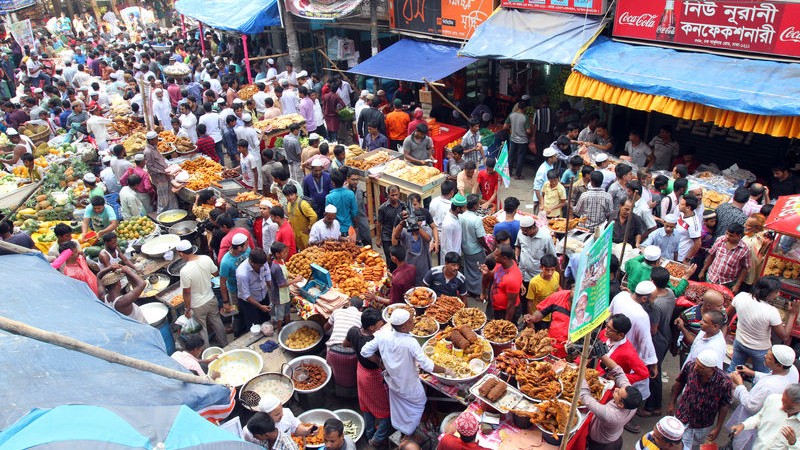
Chowkbazaar of old Dhaka is the place for the traditional Iftar market in Bangladesh. According to historians, the market started before 1857. Image by SK Hasan Ali. Copyright: Demotix (30/6/2014)
The streets in Bangladesh's capital are turning into open buffets for iftar, the sunset meal during the Islamic month of fasting Ramzan, or Ramadan as it is called in Arabic.
More than 90 per cent of Bangladesh's population is Muslim. So it is no surprise that in Ramzan — when Muslims refrain from food, drink, and sex from sunrise to sunset — the culture around food in the country transforms.
From restaurants in luxurious hotels to small street vendors, everyone has a special menu and lay-out during this month. On the road side, sizzling iftar items are transferred from open air stoves to street-side displays, as vendors call out to customers.
This BDNews24.com video gives a peek at the grand atmosphere of the Iftar market in old Dhaka's traditional Chowk Bazaar, which historians say has been around for about four centuries.
According to historians, some of Dhaka's “shahi” or royal iftar foods date back to the sixteenth century, when Dhaka was part of the Mughal empire.
Shahi Jilapi

Shahi Jilapi (fried swirls of dough soaked in sugar water), a famous sweet delicacy of Dhaka. It dates back to the Mughal period. Image by Reporter#11455. Copyright: Demotix (21/7/2012).
Shahi Haleem
Shahi doi bora
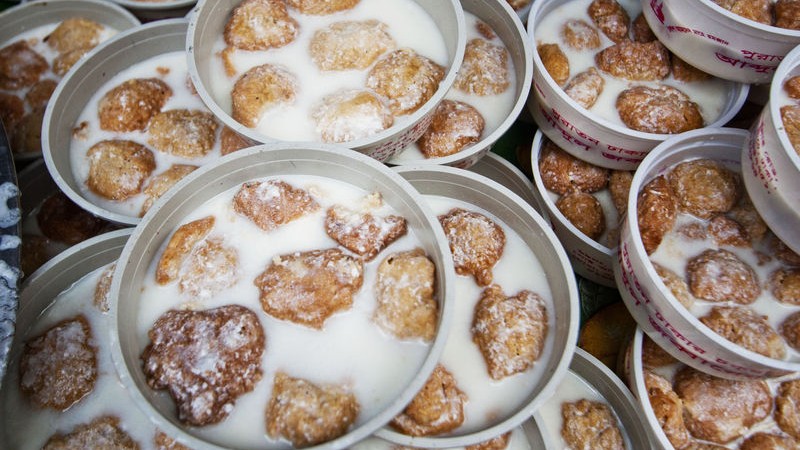
Shahi doi bora (fried and spiced lentil balls dipped in yoghurt) is a special kind of dish often included in an Iftar Menu. Image by Fahad Kaizer. Copyright: Demotix (30/6/2014)
Blogger Boka Manush Bolte Chai writes:
ষোড়শ শতকে মোঘল সাম্রাজ্য বিস্তৃত হয়ে ঢাকায় ডেরা ফেলার সময়টায় তারা সাথে করে নিয়ে আসে তাদের রাঁধুনি দলকে। কারণ, মোঘলদের অন্যতম বৈশিষ্ট্য ছিল আরাম আয়েশ আর বিলাস বহুল জীবনাচার যার অন্যতম অনুষঙ্গ ছিল তাদের মুখরোচক নানান খাবার দাবার। আর এসব খাবারের অন্যতম উপাদান ছিল হরেক রকম মশলা আর তেলের যথেষ্ট ব্যবহার। আর মোঘলদের এই বিলাসী জীবন যাপনের জন্য সাথে করে বয়ে আনা কর্মচারী-খানসামা-বাবুর্চি একসময় যথেষ্ট হয়ে উঠে না, ফলে আশেপাশের লোকালয় হতে বহু লোকের চাকুরী জোটে মোঘল পরিবারসমূহে। অন্যান্য পদের মত হেঁসেলেও স্থান হয় কতিপয় রন্ধন কারিগরের। আর তাদের হাত ধরেই মোঘল খাবার প্রাসাদের বাইরে বিস্তৃতি পায়।
In the sixteenth century the Mughal empire expanded its reign to Dhaka. When they first built a camp in Dhaka, they brought their own cooking team. Mughals cherished their comfort and led a luxurious lifestyle. Their culinart art was one of the important parts of their way of life. Their cooks used extravagant spices and excess oil to make the food delicious. To keep pace with the luxury of living of the Mughal families their own employed waiters and cooks were not enough and so they hired many local people to serve them. Some of them were trained in the Mughal culinary arts. Through these cook, Mughal cuisine spread in Dhaka city outside of the palaces.
Suti Kabab
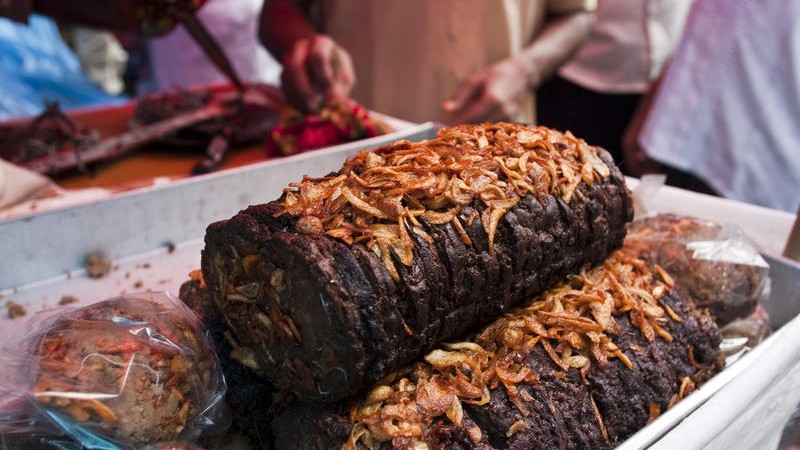
Suti Kabab (marinated minced meat kebab bound together in threads). Image by Reporter#11455. Copyright: Demotix (12/8/2010)
Raan

‘Raan’ roast – Mutton leg roast – It is also popular as a wedding ceremony dish. Image by SK Hasan Ali. Copyright: Demotix (30/6/2014)
Chicken roast
Goat roast
Boro baper polay khai
When selling the boro baper polay khai, vendors usually sing out this rhyme: boro baper polai khai, thonga bhoira loiya jai or the big shot’s son eats it and buys a packet to take home.
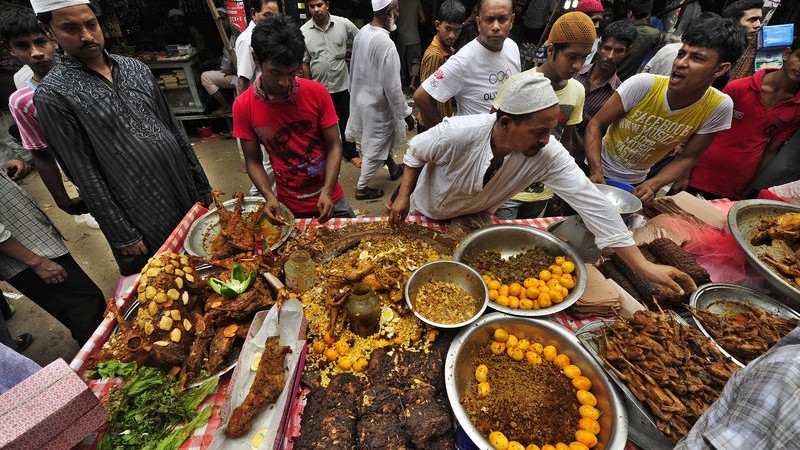
The most popular delicacy “boro baper polay khai”, made by 13 spices and ghee including a mixture of chickpeas, beef brain, minced meat, potatoes, dried rice, egg, chicken. Image by Firoj Ahmed. Copyright Demotix (21/7/2012)
And at the average Bengali household, this is what the iftar spread looks like:
The Iftar is not only limited to family feasts in Bangladesh. It also helps build community bonds. The caption below says, “Buddhist monks are serving food (Iftar) to hundreds of poor Muslims during Ramadan. This is an example of social harmony between religions in Bangladesh.”
“Bangladeş'in başkenti Dakka'daki bir Budist tapınağı, her gün müslümanlara iftar yemeği veriyor..”@ntahakilinc #bangladesh #dakka #budist #müslüman #iftaryemeği A photo posted by طوبا (@tubadursun793) on
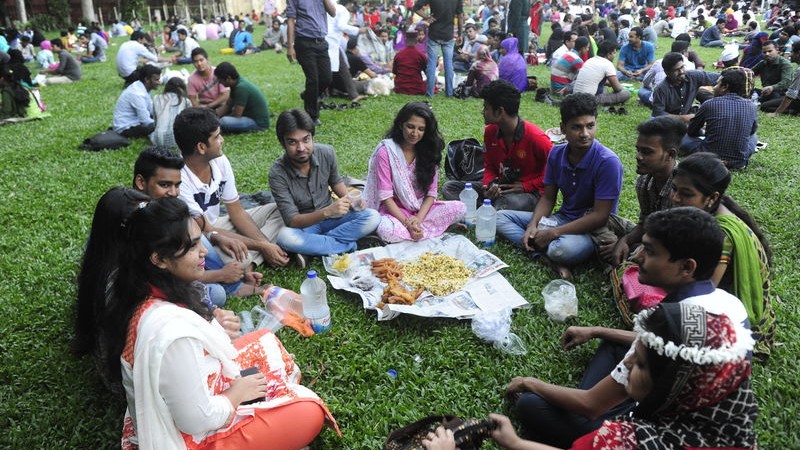
People gathering to break their fast together at Teacher Student Centre (TSC), University of Dhaka. Image by Mohammad Asad. Copyright: Demotix (29/6/2015).
Asha writes in a blog:
In Bangladesh, a wide variety of foods is prepared to break the fast at Maghrib (evening prayer) time. Some of the common iftar items from Bangladeshi cuisine include Piyaji (made of lentils paste, chopped onions, green chilies, like falafel), Beguni (made of thin slices of eggplant dipped in a thin batter of gram flour), Jilapi, Muri ( puffed rice similar to Rice Krispies ) , yellow lentil grains, usually soaked in water and spiced with onion, garlic, chilli and other iftar items), Haleem, dates, samosas, Dal Puri (a type of lentil based savoury pastry), Chola (cooked chickpeas), fish kabab, mughlai paratha (stuffed fried bread with minced meat and spices), pitha, traditional Bengali sweets and different types of fruits such as watermelon. Drinks such as Rooh Afza and lemon sharbat are common on iftar tables across the country. People like to have iftar at home with all family members and iftar parties are also arranged by mosques.
Blogger Mohammad Ilius Chawdhury writes about the rush at a mall during iftar time in Somewhereinblog:
ইফতার সময়ের আধ ঘন্টা আগে এসেও দেখি এই লেভেলে তিল ধারণ করার স্থানটুকু নেই। সব সীট বুকড। তারপর করিড়োর, হাটার চিপা গলি, মেঝের মাঝখান সব খানেই ব্লকড। কিছু খাবার অর্ডার দিয়ে যে নিয়ে আসবো সেই পথটুকুও যেন বন্ধ। […]
Half an hour before iftar time I reached the food court level. It was so crowded. All the seats were booked. Even corridors, narrow walking lanes and section of the floor were blocked by people waiting for Iftar. There was no way to get pass them to some Iftar from the food court […]

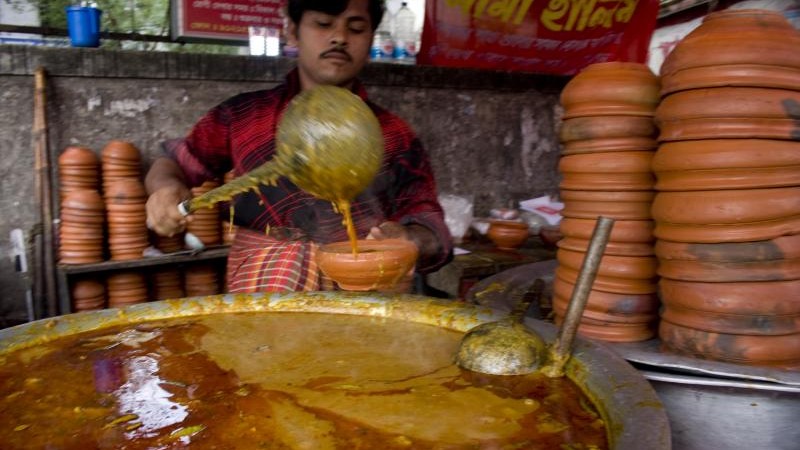
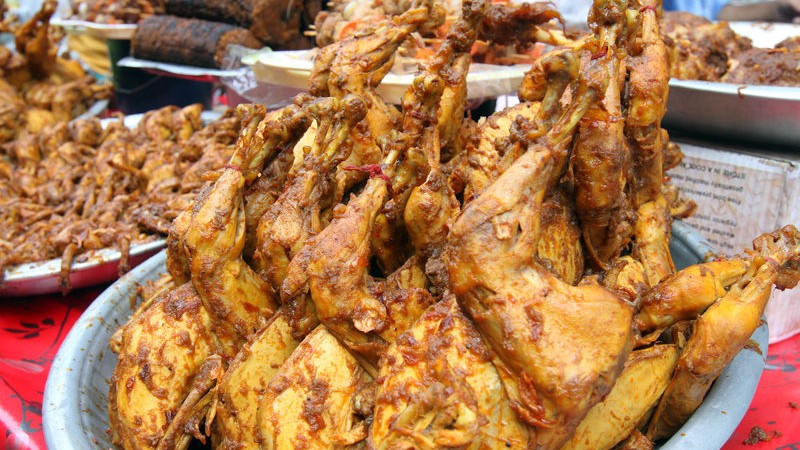







3 comments
Indeed, mouth watering.
My son and I recently found a restaurant in or near Orlando Florida, and was fortunate enough to sample many of these items at an authentic northern India style restaurant there. Delicious. We would love to go to Dhaka for Ifkar.